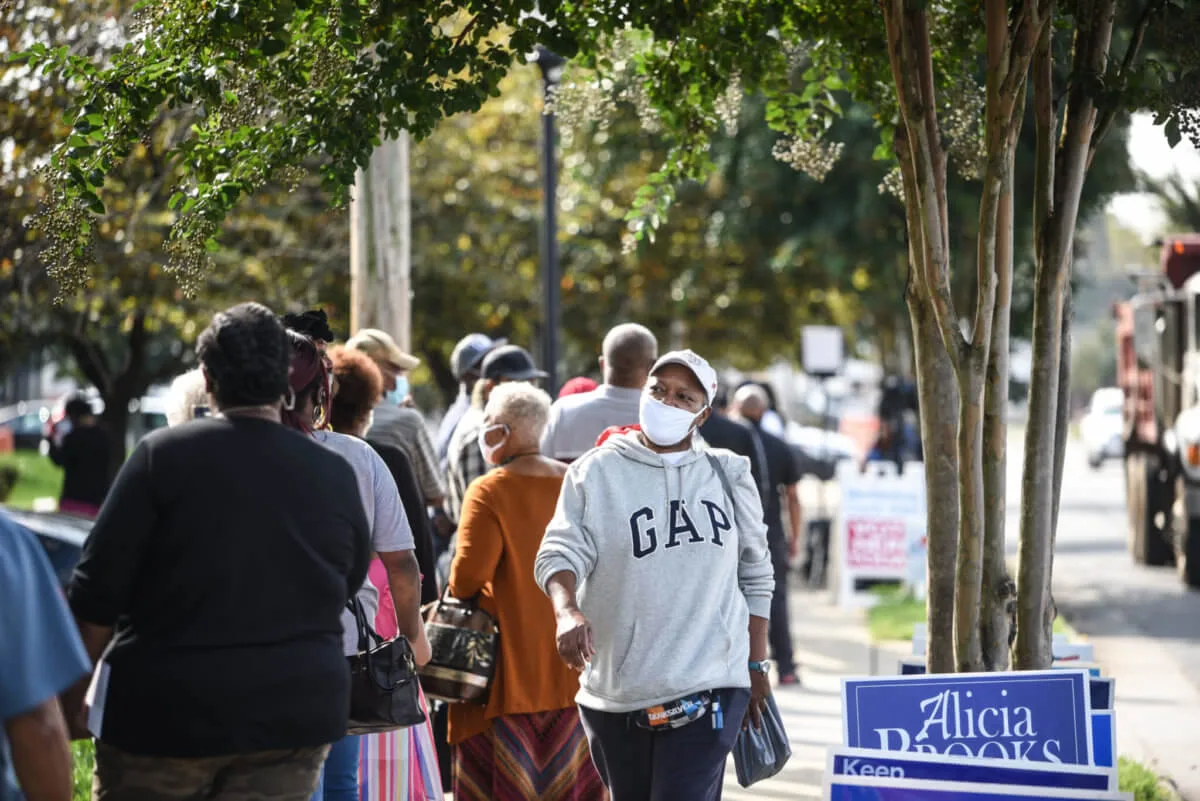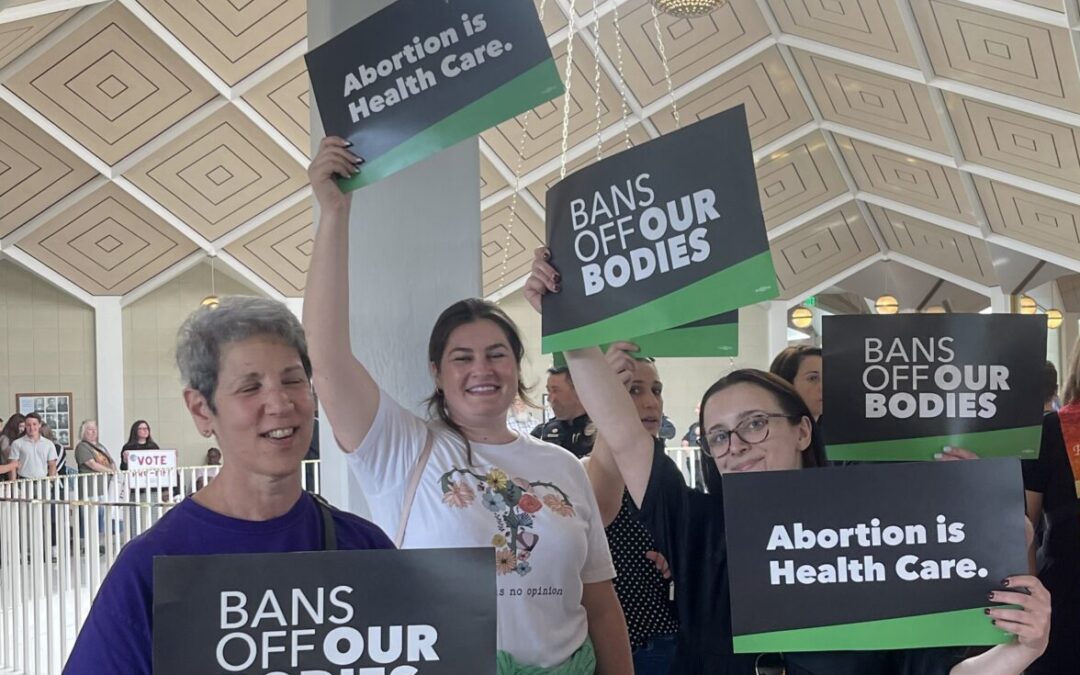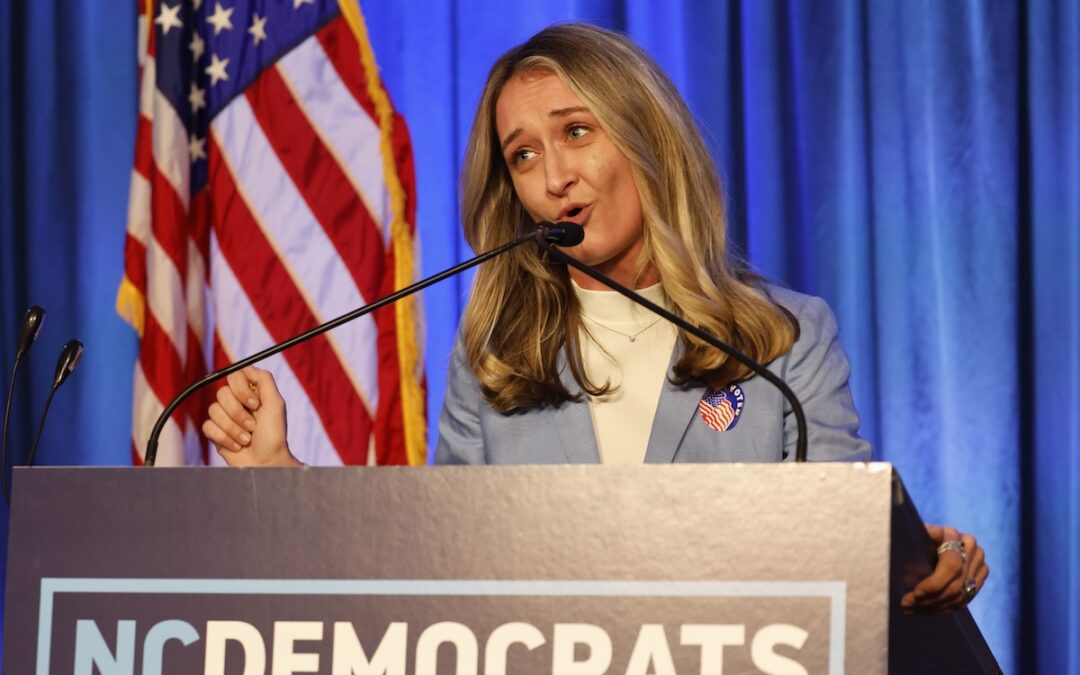
Voters stand in line waiting to cast ballots in the 2020 election at a Charlotte early voting site. The future of the state's crucial voting district maps are up in the air in the N.C. Supreme Court today. (Photo for Cardinal & Pine by Alvin Jacobs Jr.)
The top court in North Carolina is getting ready to decide what has to happen to have “free elections.”
Free and fair elections are essential to a healthy democracy, voting rights groups say.
But the Congressional district maps drawn by Republicans in the NC legislature get in the way of voters, in particular Black voters, exercising their basic voting rights, a group of lawyers argued this week in a North Carolina courtroom.
We know North Carolina, inside and out. Subscribe to the free Cardinal & Pine newsletter.
“Every voter gets an equal say in who will represent their interests, and the will of the people as a whole determines which party controls the levers of power,” R. Stanton Jones, a lawyer representing Rebecca Hall, a member of Common Cause NC said in his opening statement. But, “in a partisan gerrymander the leaders already in power manipulate the district lines to subvert the will of the people.”
That’s the basis of arguments heard at the NC Supreme Court on Wednesday, as the state’s top court sets about clarifying the state’s voting rights and political make-up.
If upheld, the North Carolina maps will be used for the next decade. If the court rules the maps are unconstitutional, it could then do several things, including order the legislature to redraw the maps on its own, order it to consult an independent expert, or even enact maps already offered by the groups bringing the suit.
The justices, four Democrats and three Republicans, have not said when they will rule, but a decision is expected to come quickly.
How Much Does Fairness Count?
At issue are the election maps drawn by the state legislature last year. The maps were widely criticized by voting groups and independent analyses as being intentionally skewed toward Republicans and biased against voters of color.
Much of the back and forth in court Wednesday hinged on the meaning of a few words – what’s an okay level of partisanship and what’s extreme; what “the will of the people” really means; and whether a state requirement for “free elections” meant those elections have to be fair, too.
The big legal questions the justices will answer are:
- Do elections in North Carolina have to be fair when it comes to how districts are carved up?
- Has the Republican-controlled General Assembly violated the will of the people by drawing election maps that all but ensure their party’s dominance for the next decade?
- Does state law allow the legislature to draw the maps however they see fit?
- Does the NC Supreme Court have the authority to redraw or call for new maps to be made?
The state constitution prohibits only “extreme” gerrymandering, and so, lawyers for the Republican lawmakers argued, some partisan intent is allowed and is perfectly legal.
The law is quiet, however, on what specifically defines what’s acceptable and what’s “extreme.” For the court to rule that these maps crossed the line, Phil Strach, a lawyer for the lawmakers, said, it would first have to define that line, something other appellate courts have declined to do.
It falls to the legislature to specify those terms, Strach said, and not the courts. For the courts to make such a ruling, he said, would amount to “legislating from the bench.”
Behind the Lawsuit
Several groups, including the NC chapter of the NAACP and Common Cause NC, filed lawsuits in the fall over various parts of the maps and processes used to draw them, but the State Supreme Court combined the cases into one.
The new maps would give Republican candidates an uncontested path to 10 of North Carolina’s 14 Congressional House seats. Voters in NC overall, however, are split evenly between the parties and have elected a Democratic governor two terms in a row, and went for Trump over Biden by a small margin.
The new maps would also split several areas with a large number of Black voters across several new districts, diluting the power of Black voters and making it more difficult to elect Black candidates. There are federal protections under the Voting Rights Act, but the US Supreme Court diluted much of them, and caused some muddiness with others, in 2013.
This, he said, is what the Republican-controlled legislature did with these maps, and both the process and the effect of the maps violate the state’s constitution’s insistence on free elections.
Lawyers for the plaintiffs rejected any arguments that the state’s highest court had no authority to intervene. If no one can define “extreme gerrymandering” then the law against it is meaningless.
“This court really is the only check here,” Zack Schauf, an attorney for the plaintiffs, said. “Elections can’t provide a check. The governor can’t provide a check. Amendments aren’t available. And it will only get worse if this court gives the General Assembly a blank check.”
Politics

Op-Ed: North Carolina Republicans are working overtime to restrict abortion even more. But we can stop them at the ballot box.
When I think about abortion access in North Carolina, I think about lying there on a hospital bed after I was sexually assaulted, with sympathetic...

Mark Robinson and Michele Morrow pose a threat to women and kids, warns Anderson Clayton
The state’s Democratic Party chair believes North Carolinians deserve better than a six-week abortion ban and the defunding of public schools that...
Local News

The 5 most believable UFO sightings ever reported in North Carolina
Read about five alien encounters that may forever remain unexplained. When you think of the most common places where you might hear a UFO sighting...

Good News Friday: It’s a good day to be a fan of the NC State Wolfpack
The men's and women's teams will compete for a national championship in college basketball this weekend. Plus: How to watch the solar eclipse, and...





